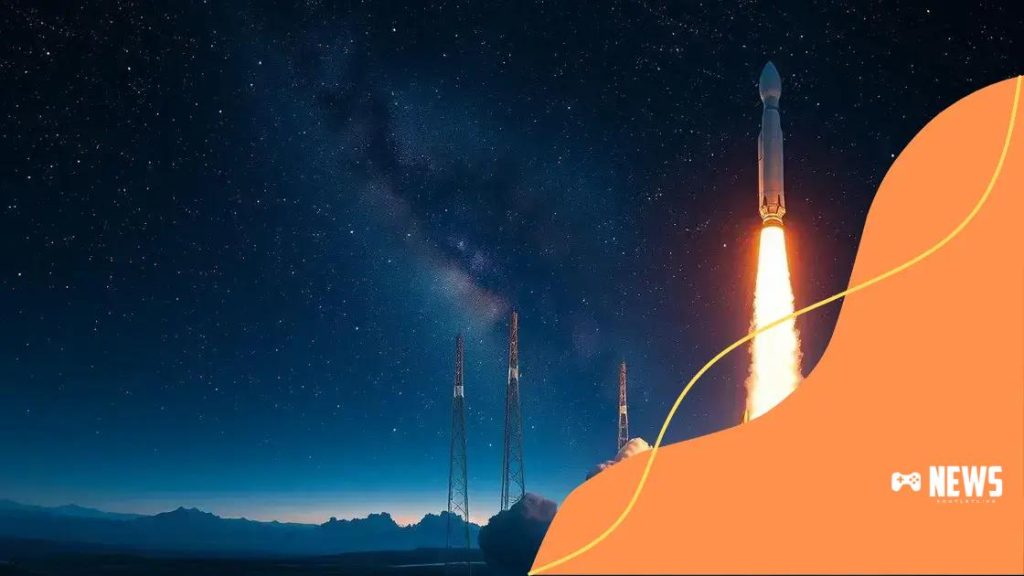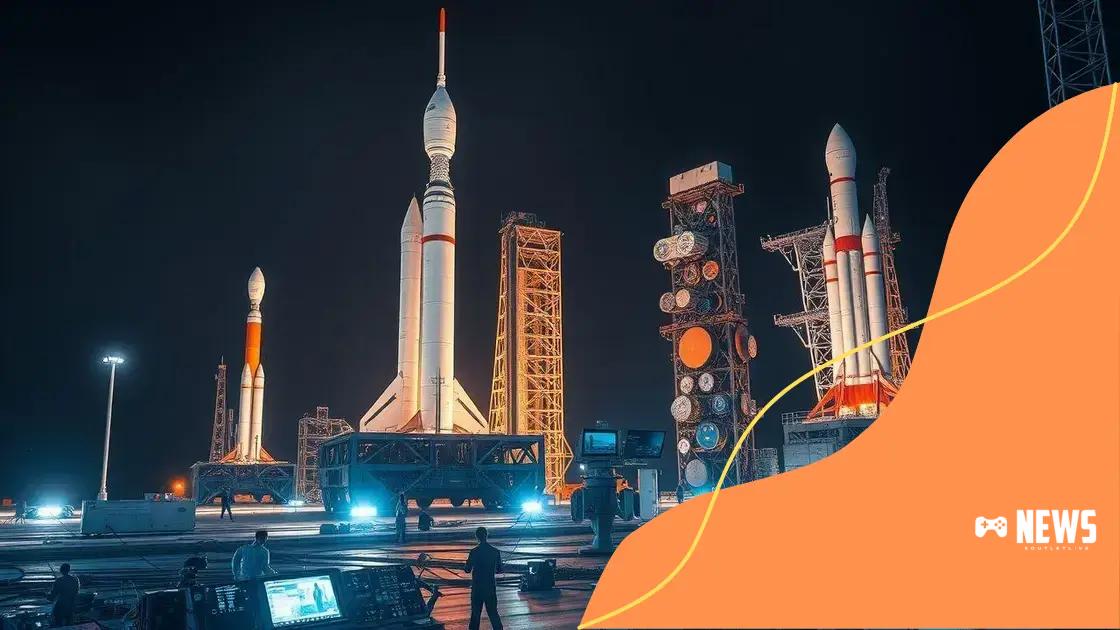Space exploration missions planned for 2025 to watch out for

Space exploration missions planned for 2025 will focus on expanding our knowledge of the universe, enhancing technologies, and fostering international collaboration, potentially paving the way for human life beyond Earth.
Space exploration missions planned for 2025 are set to unveil new mysteries of the universe. Are you ready to discover what our future holds among the stars?
Upcoming crewed missions
In 2025, several exciting crewed missions to space are set to launch. These missions will pave the way for exploration, research, and potential colonization of other planets. Astronauts will once again venture beyond Earth’s atmosphere, expanding our horizons and using advanced technology to drive these expeditions.
Key Crewed Missions Planned
Among the notable missions, we can look forward to:
- Artemis II: This mission aims to return humans to lunar orbit and test systems required for future moon landings.
- Starship Crewed Flights: SpaceX’s Starship intends to take crew to destinations such as the Moon and Mars as part of its ambitious plan.
- International Space Station (ISS) Expeditions: Ongoing missions will see astronauts continuing vital research aboard the ISS.
The Artemis II mission is particularly fascinating, as it will be the first mission to carry astronauts to the Moon since Apollo 17. This mission will help plan for long-term human presence on the Moon, establishing a base for further exploration of Mars.
Training for Space Travel
Astronauts undergo rigorous training in preparation for these missions. They prepare for different scenarios, from operating spacecraft to conducting scientific experiments in microgravity. Training sessions are demanding and simulate real-life challenges that can arise in space.
In addition, developing new technologies to support crew safety and mission success is ongoing. As we approach 2025, the excitement around these upcoming crewed missions continues to build, capturing the imagination of many.
Uncrewed missions that could reshape our understanding
In 2025, numerous uncrewed missions are set to launch, aiming to expand our knowledge and explore the far reaches of space. These missions are crucial as they often carry advanced technology to distant destinations, allowing us to gather data without the risk to human life.
Significant Uncrewed Missions
Several key missions are on the calendar:
- James Webb Space Telescope: This telescope will significantly enhance our ability to observe distant galaxies and cosmic phenomena.
- Perseverance Rover: Continuing its exploration of Mars, it will seek signs of ancient life and collect samples for future return missions.
- Dragonfly Mission: A revolutionary mission to explore Titan, Saturn’s largest moon, using a flying drone to analyze its surface and atmosphere.
These missions highlight how uncrewed technology plays an important role in space exploration. For instance, the James Webb Space Telescope will allow us to look back in time, providing insights into the universe’s formation. It can track exoplanets and potentially identify signs of life.
Technological Innovations
Innovations in robotics and artificial intelligence are crucial for uncrewed missions. These missions utilize tools that can operate autonomously or be controlled from Earth, ensuring they gather essential data in extreme conditions. Moreover, advancements in communication systems allow scientists to receive information faster than ever.
The focus on uncrewed missions, such as the Perseverance Rover, exemplifies how these efforts broaden our perspective. By studying Mars’ geology and atmosphere, we can learn about potential past life and future habitability, helping us understand not only Mars but also Earth’s history.
Technological advancements for 2025 missions

As we approach 2025, several technological advancements are set to enhance our space missions. These innovations will improve safety, efficiency, and the potential for groundbreaking discoveries. From propulsion systems to communication technologies, the progress is remarkable.
Innovative Propulsion Systems
One significant area of advancement is propulsion technology. New rocket designs focus on better fuel efficiency and speed. For example, electric propulsion engines, which use ions for thrust, are becoming more common. This technology allows spacecraft to travel farther while consuming less fuel.
- Ionic propulsion: Provides longer flight times and reduces the need for heavy fuel.
- Nuclear thermal propulsion: Offers faster trips to distant destinations, such as Mars.
- Reusable rocket systems: SpaceX and Blue Origin are leading in creating rockets that can return to Earth safely for reuse.
These advancements not only decrease costs but also make space travel more sustainable. Each launch can focus on transporting critical equipment and scientific instruments instead of worrying about excessive fuel loads.
Enhanced Communication Technologies
Another exciting area is communication systems. Upcoming missions will rely on advanced technologies to ensure real-time data transmission. For instance, the new laser communication systems allow faster data transfer compared to traditional radio waves. This will enable scientists to receive information more quickly, aiding in prompt decision-making.
Investing in AI and machine learning will also change how we analyze information from missions. These technologies can process vast amounts of data, identifying patterns or anomalies even before scientists look at the data themselves. As we prepare for these missions, the blend of technological advancements and innovative thinking is paving the way for exciting discoveries.
Key players in the space race
The space race is more vibrant than ever, with various key players leading the charge into the cosmos. As countries and private companies push boundaries, they contribute to exciting advancements in space exploration.
Major National Space Agencies
Several nations have established prominent space agencies that play significant roles in exploration and research.
- NASA: The United States’ National Aeronautics and Space Administration continues to lead in various missions, including lunar and Mars exploration.
- ESA: The European Space Agency works collaboratively on missions that explore planets, conduct scientific research, and develop satellite technology.
- Roscosmos: Russia’s space agency remains a prominent player, focusing on human spaceflight and deep space missions.
These agencies collaborate on projects like the International Space Station, where they share resources and knowledge, further advancing human spaceflight.
Private Companies Making an Impact
In addition to government organizations, private companies are revolutionizing space travel. Talent and innovation from the private sector are now pivotal in the space industry.
For example, SpaceX has made headlines with its reusable rockets and ambitious plans to colonize Mars. Their Starship aims to facilitate human migration to other planets. Likewise, Blue Origin focuses on making space travel accessible to everyone, with plans for commercial space tourism.
Other companies, like Northrop Grumman and Boeing, are also contributing technologies that support NASA and international missions. Through these collaborations and innovations, space exploration is entering a new era, where the combined efforts of government agencies and private enterprises will shape the future of humanity among the stars.
What these missions mean for the future
The upcoming missions to space represent more than just technological achievements; they hold significant implications for the future of humanity. As we advance our understanding of the universe, we also unlock possibilities for life beyond Earth.
Exploring New Horizons
These missions will expand our reach into the cosmos, paving the way for potential colonization of other planets. For instance, the exploration of Mars through robotic missions and future human landings could lead to identifying suitable habitats beyond our home planet. Thus, we open the door to new realms for human existence.
- Resource Utilization: Future missions may discover resources like water and minerals, essential for sustaining human life.
- Technological Advancements: The challenges faced in these missions drive innovation in various fields, contributing to benefits on Earth.
- Scientific Knowledge: Understanding other celestial bodies can provide insights into Earth’s history and climate.
As we prepare for these exciting ventures, the idea of utilizing resources from asteroids or other planets becomes feasible. This prospect not only fuels space exploration but also addresses resource scarcity here on Earth.
International Collaboration
Moreover, these missions foster collaboration among countries, promoting peace and unity through shared goals. Space exploration often acts as a bridge between nations, encouraging joint research and mission objectives. As humanity works together, it can overcome challenges and share the benefits of discovery equitably.
Ultimately, the outcomes of these missions will reshape our future, encouraging humanity to dream bigger and push boundaries. With an eye on the stars, we can enhance our lives here on Earth while seeking new homes among the galaxies.
FAQ – Frequently Asked Questions about Space Exploration Missions
What are the primary goals of upcoming space exploration missions?
The primary goals include expanding our understanding of the universe, exploring Mars, and potentially identifying resources for human colonization.
How do international collaborations enhance space missions?
International collaborations allow countries to share resources, knowledge, and expertise, making missions more efficient and successful.
What technological advancements are being developed for these missions?
Innovations such as advanced propulsion systems, improved communication technologies, and AI for data analysis are being developed.
Why is studying other planets important for Earth?
Studying other planets helps us understand Earth’s history, climate, and potential future challenges while opening possibilities for human life beyond Earth.





